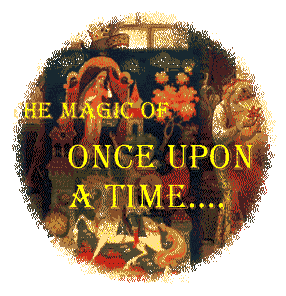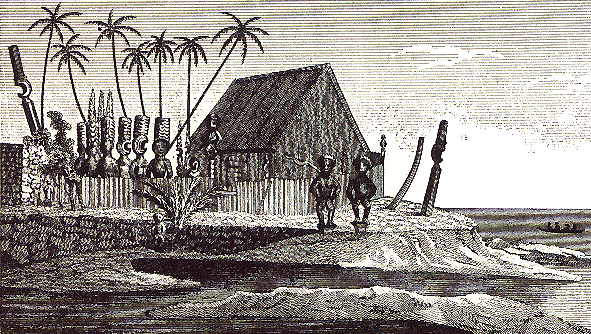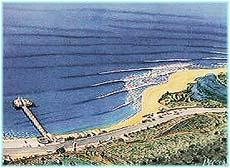|

Narrative Logo - Click for Main Menu
Lecture
VIII. The Socio-Economic Interpretation of Folktales
Modern
Collections and their Implications 1& 2
Part 2 Contemporary
Fairy Tales
well, the making of contemporary legend.
Tourism is a fine source of new
legend-making, and Hawaii is one place that discovered the tourist gig early on.

Caption: Ancient Hawaiian Scene, Totems, Hut,
beach and canoe
I am particularly fascinated by the
Surfboarding legends. The Boards, the Places, and the Heroes--all the stuff of
woven, ancient and modern, legend-making. (from the
Legendary
Surfers Page)
Sunset Beach
- Paumalu
Forty miles from Ke-kai-o-Mamala, on the North Shore, Paumalu was known for its big
waves, just as it is known, today, by the different name of "Sunset Beach."
In the old days, it was called Paumalu, which means "taken secretly." This
reference went back to the days of kapu when a woman who once caught more octopus than was
permitted there, had her legs bitten off by a shark.
In another legend, an ali`i of Kaua`i named Kahikilani crossed the hundred miles of open
sea between his home and O`ahu just to prove his prowess in the great surf there.
As we saw in Chapter One, Kahikilani had an unfortunate affair with a bird maiden and
ended-up petrified. His image, complete with a petrified lehua lei around his neck,
stands on a barren ridge above Paumalu Bay, even today.
The Olo Surfboard
The olo was the more impressive of the Hawaiian boards and was reserved exclusively
for the ali`i, the Hawaiian ruling class, in accordance with the kapu (taboo) system. It's
possible that while the wili wili board of olo design was reserved for the use of the
chiefs, the koa board of olo design was not off-limits to the common people -- the
maka`ai-nana -- for general use. This may have been because of the scarcity of wili wili
and plentiful occurrence of koa.
In the cross-section, the olo was thicker than the alaia and could weigh up to around 160
pounds. Some late 1700s European writers described boards that certainly were even
heavier and up to twenty-four feet long. At that length, the weight of the boards would
be well over 200 pounds. 1930s surfer Northrup Castle had a board weighing more than
Abner Paki's; that was in the 200-pound range, "and he likes it," noted Tom
Blake.
The olo was designed and shaped for large humping swells which roll in only in a
limited number of surf spots, the most notable being Waikiki, on the South Shore of
O`ahu. The olo ride was very long, but maneuverability was extremely limited. During
the late 1920s, Tom Blake and then Duke Kahanamoku built 16-foot redwood boards
according to olo specifications, testing them at Waikiki. In fact, the riding styles
required
to maneuver these replicas helped reconstruct most of what we know of the earlier olo
technique. The olo's length and bulk allowed it to catch a swell long before it broke and
further out to sea. Once the wave was caught, a surfer could slide easily along, even
after the wave broke and started to flatten out. At the kulana nalu -- the take-off spot
--
an olo might even catch a wave that began to peak but never broke; the kind of wave
not uncommon for Waikiki when the swell is weak.
"Once on a wave" with an olo, noted Hawaiian chronicler John Papa Ii, "with
the ride's
angle set, the surfer had difficulty making fast turns, especially when the wave grew
steep." Also, the huge board was hard to paddle through broken waves and sometimes
had to be carried by canoe around the rushing waves to the kulana nalu.
`Owili (o-WE-lee) and `Onini (o-NEE-nee) are two names given to the olo board. The
`Owili was an olo made out of wili wili. The `Onini was an olo known for its difficulty in
riding and used only by experts. What the exact differences between these two olo
boards were is unknown, exactly, but may have had to do with the type of wood used.
The olo was of particular interest to Tom Blake who, in part due to his research into the
old Hawaiian boards, went on to invent the hollow board. Blake pointed out that since
wili wili is "a porous light wood like balsa," an alaia designed board of wili
wili would not
be strong enough. Duke Kahanamoku's answer to why the old wili wili boards were
reserved for the chiefs was that the light weight wood was scarce and highly valued.
"Therefore," wrote Duke, "the chiefs had wili wili boards for the same
reason that a man
has a Rolls-Royce automobile today, that he is wealthy and can afford it."
Because of the olo's limitations, it's tempting to dismiss the board as simply what the
ali`i rode, but never in really large surf. However, both Duke and Blake rode their olo
replicas at Castle and Papa Nui (outside Cunha) on big days in the 1920s and '30s.
Certainly, the big wave boards of today are quite narrow and, compared to all other
surfboards, very long, so there is a connection. As previously noted, all classes, ages and both sexes enjoyed surfriding in
pre-European Hawai`i. Although early European accounts do not mention who surfed
the most, eye-witness descriptions usually refer to adult men and women, with
occasional reference to children riding smaller boards closer to shore. Except on those
beaches where the most dangerous swells peaked and kapu restrictions applied, men
and women shared surfing areas equally.
Compared to today's rather low ratio of surfing females-to-males, a large percentage of
wahines of early Hawai`i were skillful surfers. Early European engravings are full of
half-dressed island girls riding papa he'e nalu quite naturally.
As noted earlier, Ke-kai-o-Mamala, one of O`ahu's finest ancient surf spots, was named
after the expert woman surfer Mamala. Thomas Thrum, writing in an 1896 article
entitled, "Hawaiian Surf Riding," stated that, "Native legends abound with
the exploits
of those who attained distinction among their fellows by their skill and daring in this
sport, indulged in alike by both sexes; and frequently too -- as in these days of
intellectual development -- the gentler sex carried off the highest honors."
"This equality and sexual freedom," wrote Finney and Houston, "added zest
to the
sport and was important to its widespread popularity. No doubt many an amorous
Hawaiian, who didn't feel at all like surfing that day, found himself paddling for the
breaker line in pursuit of his lady love, knowing full well that if a man and woman
happened to ride the same wave together, custom allowed certain intimacies when
they returned to the beach. More formal courtship was also carried out in the surf, when
a man or woman tried to woo and win a mate by performing on the waves."
Surfing as courtship is corroborated in a story that appeared in one of Honolulu's first
Hawaiian language newspapers, most likely under missionary influence. In the
December 23rd 1865 issue of Nupepa Kuokoa, in an article about "Ka Holomana
Kahiko"
(Ancient Sports of Hawai`i), J. Waimau recalled that at surfing contests held in older
times, the men, looking like "a company of soldiers of that day," would wear
red-dyed
malo (loincloths) and assemble on the beach. Women would make their way to the
beach in matching red-dyed kapa skirts. Then, they would join with the men in hitting
the surf. If a man and woman rode in on the same wave together it was sometimes a
sign of attraction. If that was the case, it was entirely natural for the two to later get
into
it, sexually.
"Hawaiian legends abound in tales of thwarted and successful love affairs,"
wrote Ben
Finney, "and surfing played a part in many of them. Great romances could blossom or
fade with the rising and falling of ocean swells. Passionate adventures of champion
surfers, and some of the famous courtships that began on the edge of the ocean were
recorded in Hawaii's abundant oral history. They indicate surfing's significance in the
unwritten literature of the Hawaiian people."

Caption: Sketch of Ancient Hawaiians Surfing
Similarly, the guidebooks and brochures are full of created Hawaii lore:
Moki’s Law: The chance of you dividing a manapua evenly in
half depends upon how much you want to share it.
Moki’s Law: The syrup in your shave ice will always run out
before the ice.
Moki’s Law: When all else fails, say you’re a tourist.
Moki’s Law: Clouds always have a way of following you to the
beach.
Moki’s Law: The best waves for surfing will always break while
you’re in school or at work.
Moki’s Law: The poi dog you got free from a friend will always
be smarter and cuter at their house.
Moki’s Law: There is always one more cockroach.
Moki’s Law: The guy you’re crazy about will always ask you out
on a night you have to go to a family gathering.
Moki’s Law: If an invitation says dinner at 6 PM (Hawaiian time)
you can safely assume they mean 7:30 PM.
Moki’s Law: Formal in Hawaii is a long sleeve T-shirt with rubber
slippers that don’t smell.
Moki’s Law: When in doubt talk pidgin, when in trouble talk
Hawaiian.
Moki’s Law: The chance of you losing the top of your shave ice
is directly proportional to how long the line was.
Moki’s Law: The page you need in the public telephone booth
will always be missing.
In keeping with our theme of looking at the
socio-political aspect of modern folklore, we might examine these examples and see what we
find. Surely, the national character, as defined by the Hawaiians, themselves, is
evident everywhere in their folklore. The example of Hawaii is a good one to study,
as the culture is much more explicitly evoked in the Hawaiian lore than in many others.

Captiuon: The great Mick Dora
Legendary
Surfers
or, closer to home, the Malibu Legend:

Caption: The Point at Malibu
Originally home to the members of the Chumash and Gabrielino tribes, Malibu had been
inhabited for approximately 7,000 years. The word "Malibu" is a corruption of
the Chumash word Maliwu, the name of the Chumash village located at the mouth of Malibu
Canyon, near Malibu Point.
Following the area's takeover by the Spanish in 1805, 13,316 acres of shoreline and
adjacent
mountain land were granted by the Spanish government to Jose Tapia, a former soldier. The
land was included as part of what became Rancho Topanga Malibu Sequit.
end Lecture VIII.
Return to Menu
|




